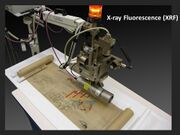Difference between revisions of "X-ray fluorescence (XRF) spectroscopy"
| (2 intermediate revisions by the same user not shown) | |||
| Line 1: | Line 1: | ||
| + | [[File:MFA XRF instrument.jpg|thumb|Non-destructive XRF analysis of a Chinese painted scroll using an open architecture Bruker Artax XRF (MFA.org)]] | ||
== Description == | == Description == | ||
| + | A nondestructive analytical method used to qualitatively and semi-quantitatively determine the elemental content of materials. X-ray Fluorescence (XRF) spectroscopy The secondary x-rays emitted from each element has a unique set of energies thus allowing its identification; the combined energy spectrum produced from an analyzed sample provides the qualitative as well as quantitative identification of the components. Detection limits vary depending on instrument, elements, and sample matrix. The instrument source can be an x-ray tube, synchrotron, or a sealed radioactive source. Since removing a sample is unnecessary, XRF analysis is often one of the first analytical methods for surveying the inorganic components in a museum object, such as the composition of metals, glass, stones, and ceramics. Pigments in paintings, drawings and prints can usually be inferred, then supplements with other techniques, such as multispectral imaging, optical microscopy, as well as Raman and FTIR spectroscopies. | ||
| − | + | A similar x-ray spectrum is generated by the emission of x-rays using an electron beam as a source in a scanning electron microscope (SEM); that detector is called Energy Dispersive Spectroscopy (EDS). Typically, for an XRF instrument in air, calcium is the lowest atomic number element measured; when air is evacuated, such as in a SEM, the lowest detectable element is carbon. | |
== Synonyms and Related Terms == | == Synonyms and Related Terms == | ||
Latest revision as of 15:18, 16 November 2023
Description
A nondestructive analytical method used to qualitatively and semi-quantitatively determine the elemental content of materials. X-ray Fluorescence (XRF) spectroscopy The secondary x-rays emitted from each element has a unique set of energies thus allowing its identification; the combined energy spectrum produced from an analyzed sample provides the qualitative as well as quantitative identification of the components. Detection limits vary depending on instrument, elements, and sample matrix. The instrument source can be an x-ray tube, synchrotron, or a sealed radioactive source. Since removing a sample is unnecessary, XRF analysis is often one of the first analytical methods for surveying the inorganic components in a museum object, such as the composition of metals, glass, stones, and ceramics. Pigments in paintings, drawings and prints can usually be inferred, then supplements with other techniques, such as multispectral imaging, optical microscopy, as well as Raman and FTIR spectroscopies.
A similar x-ray spectrum is generated by the emission of x-rays using an electron beam as a source in a scanning electron microscope (SEM); that detector is called Energy Dispersive Spectroscopy (EDS). Typically, for an XRF instrument in air, calcium is the lowest atomic number element measured; when air is evacuated, such as in a SEM, the lowest detectable element is carbon.
Synonyms and Related Terms
XRF; analyse par fluorescence X (Fr.); spettrofotometria XRF (It.); Röntgenfluoreszenzanalyse (RFA) (Deut.); Röntgenfluoreszenzspektroskopie (RFS) (Deut.); röntgenfluorescentiespectrometrie (Ned.); análise por fluorescência de raios X (Port.)
Resources and Citations
- E.S. Lindgren, Special millennium issue on cultural heritage, X-ray Spectrometry, 29 (2000) 1
- R. E. van Grieken, A. E. Markowicz, Handbook of X-ray spectrometry, 2nd edition, M. Dekker, New-York (2002)
- National Gallery of Art, Scientific Research: Glossary of Conservation Terminology
- http://www.c2rmf.fr/homes/home_id21988_u1l2.htm
- L. D. Glinsman, The Application of X-Ray Fluorescence Spectrometry to the Study of Museum Objects, Doctoral Thesis, University of Amsterdam, 2004.
- Walter C. McCrone, John Gustave Delly, The Particle Atlas, W. McCrone Associates, Chicago, IV, 1972
- Ancient Egyptian Materials and Technologies, Paul Nicholson, Ian Shaw (eds.), Cambridge University Press, Cambridge, 2000 Comment: B.Aston, J.Harrell, I.Shaw, "Stone" and P.Nicholson, J.Henderson, "Glass"
- Wikipedia: X-ray fluorescence (Accessed June 2023)
- Richard S. Lewis, Hawley's Condensed Chemical Dictionary, Van Nostrand Reinhold, New York, 10th ed., 1993
- Art and Architecture Thesaurus Online, https://www.getty.edu/research/tools/vocabulary/aat/, J. Paul Getty Trust, Los Angeles, 2000
